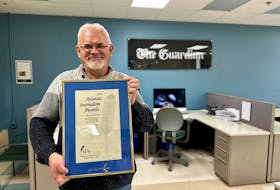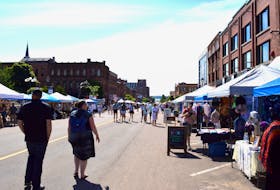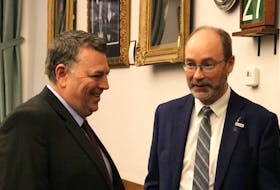Jesse Hitchcock
Guest Opinion
You may not have heard about it, but you’ve certainly seen it.
Every summer, like clockwork, the rivers and estuaries on P.E.I. fill up with big floating mats of sea lettuce. You’ll notice it when your propeller gets clogged, or when paddling your canoe gets more and more cumbersome. If you live near one of the most impacted shorelines, you definitely notice it when you try to walk down to the water and have to wade through the squishy, rotting masses on the beach.
This isn’t just a normal part of living on the coast. This is a systemic problem, and it starts with what we do on land. In biology, we call it eutrophication, but that’s just a technical way of describing what happens when we add nutrients to an aquatic ecosystem. P.E.I. is an agricultural province: we grow crops, and sometimes we fertilize them too. The problem is a lot of that fertilizer actually ends up in the water.
Instead of helping to produce food, it’s actually leaching into the groundwater (often exceeding the World Health Organization safety limits) and eventually making its way into the estuaries.
This means that we’re actually fertilizing the sea lettuce and stimulating the growth of those giant floating mats.
Here’s the problem. The mats float on the surface and effectively block out all light from the water column. This means that important coastal plants like seagrasses can no longer photosynthesize and produce oxygen. When the mats start to shade themselves and decompose, the combination of reduced photosynthesis and bacterial activity cause oxygen levels to plummet. When there is no oxygen left in the water, we call it anoxia. At this point, fish swim to the surface to gulp for air or they leave the system entirely. Sedentary animals like clams can’t leave the estuary, so they are forced to hold their breath or die — which unfortunately many do. The water becomes milky white and devoid of anything other than decomposing matter and bacteria.
This is what I saw when I happened to drive out to the Wheatley River estuary in late July. I observed the same thing for the first time almost seven years ago to the day in that exact same location. In 2018, 25 P.E.I. estuaries went anoxic. This is a systemic problem that requires long-term, forward-thinking solutions. Nitrogen builds up in our groundwater and it takes time to flush out. That means there is no fast fix, and clearly what we’ve been trying isn’t working.
This is a well understood problem and the science couldn’t be more clear. It’s been studied by UPEI, the Department of Fisheries and Oceans, Agriculture and Agri-Food Canada and the P.E.I. Department of Environment. It has been the focus of intense academic research in the region, guided by the Northumberland Strait Environmental Monitoring Partnership. We know that more than 90 per cent of the nitrogen entering the Northumberland Strait comes from P.E.I. We also know that the majority of this comes from potato agriculture specifically. There isn’t a knowledge gap, there is an action gap. We need to ask ourselves and our governments why that is.
Many farmers on P.E.I. are already following best management practices and taking action to protect their watersheds.
Despite this, many are contractually obligated to meet quotas under an unsustainable industrial agriculture model. Farmers are between a rock and a hard place. To show leadership, we must ensure that we are prioritizing our communities and the ecological integrity of our Island over corporate profit. We need to enforce three-year crop rotations to ensure our soil is healthy and less reliant on fertilizer. There cannot be exemptions. Farmers should be incentivized and compensated fairly to take agricultural land out of production. The ALUS Program currently delivered in P.E.I. is a good example of how this might work, though its scope is too small to achieve meaningful progress. Best management practices to utilize cover crops should be mandated, and the existing regulations around buffer zones need to be enforced vehemently.
This might seem like a problem for biologists, but it’s actually a moral predicament that is as common in politics as hearing ‘Mr. Speaker’ in the legislature.
Do we value the short-term economic profitability of large corporations over long-term sustainability? Do we care more about the needs of stakeholders and lobbyists than we do about our own communities? Our water? Our soil?
These questions are relevant to more than estuaries, but the principles still apply. I hope, for P.E.I.’s sake, that we stop thinking in four-year cycles and choose a responsible path forward.
Jesse Hitchcock holds a master of science (M.Sc.) degree in Environmental Science from UPEI and is the founder of Young Voters of P.E.I.








